
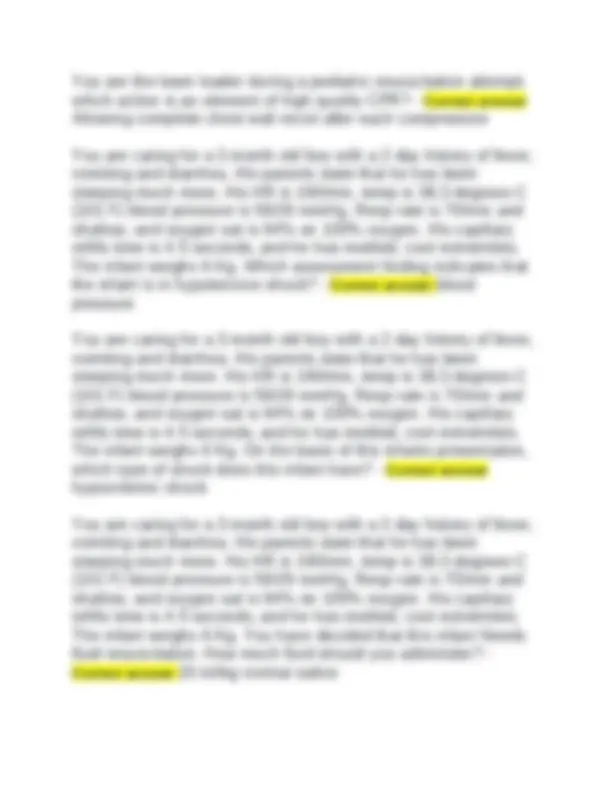
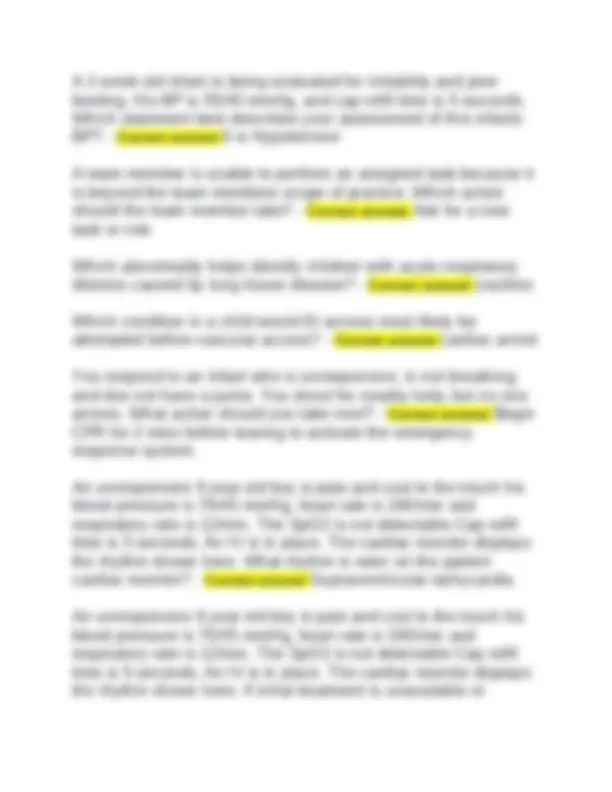
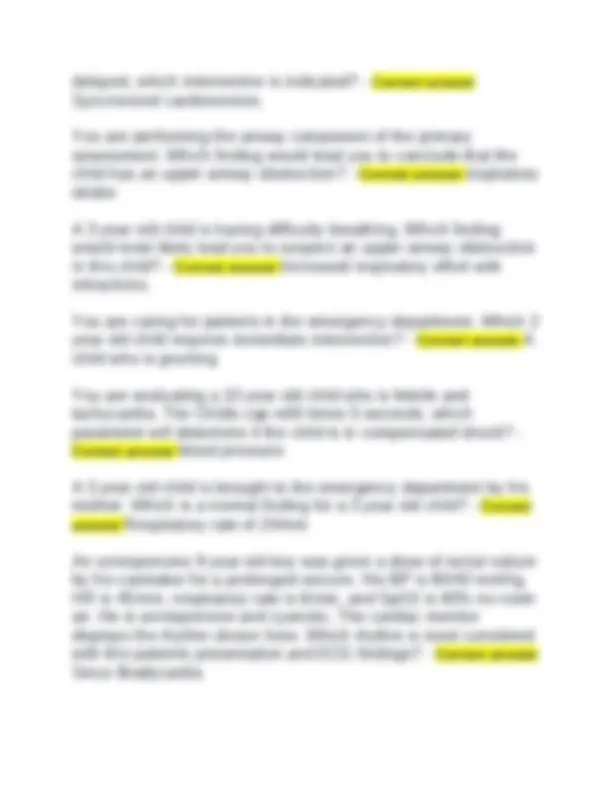
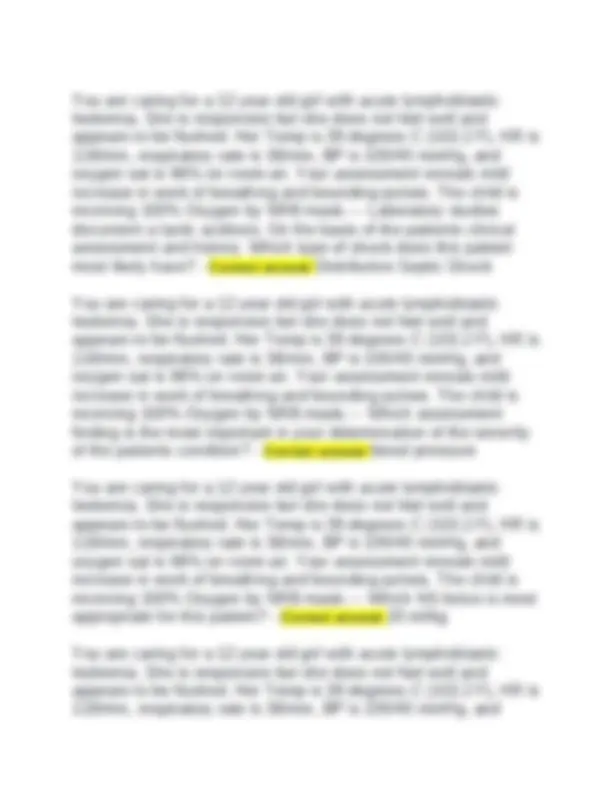

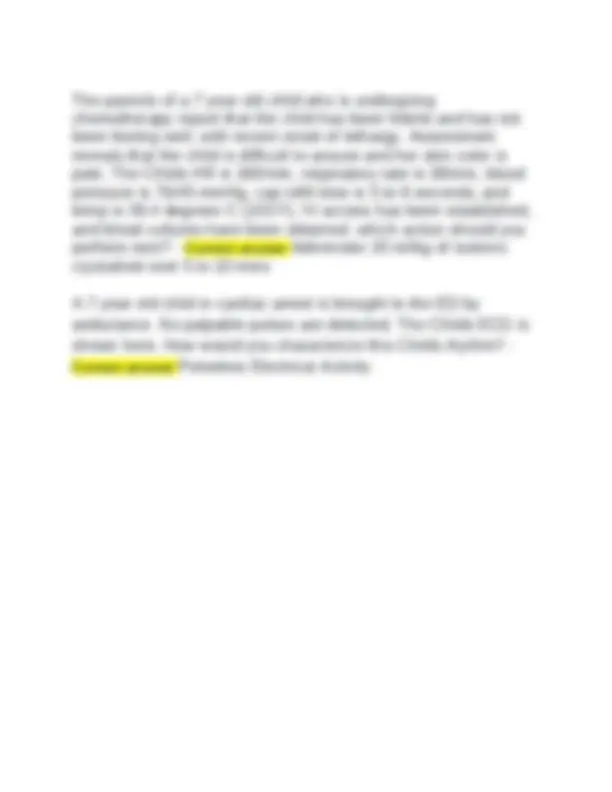


Study with the several resources on Docsity

Earn points by helping other students or get them with a premium plan


Prepare for your exams
Study with the several resources on Docsity

Earn points to download
Earn points by helping other students or get them with a premium plan
Community
Ask the community for help and clear up your study doubts
Discover the best universities in your country according to Docsity users
Free resources
Download our free guides on studying techniques, anxiety management strategies, and thesis advice from Docsity tutors
A series of questions and answers related to the pals (pediatric advanced life support) course. It covers various scenarios and clinical situations, including airway management, breathing difficulties, cardiac arrest, and shock. Designed to help students prepare for the pals post-test by providing a comprehensive review of key concepts and procedures.
Typology: Exams
1 / 10

This page cannot be seen from the preview
Don't miss anything!







A 6 month old infant is unresponsive. You begin checking for breathing at the same time you check for the infants pulse. Which is the maximum time you should spend when trying to simultaneously check for breathing and palpate the infants pulse before starting CPR? - Correct answer 10 seconds A 4 year old child is brought to the emergency department for seizures. The seizures stopped a few minutes ago, but the child continues to have slow and irregular respirations. Which condition is most consistent with your assessment? - Correct answer Disordered Control of Breathing An 8 year old child is brought to the emergency department with a 2 day history of lethargy and polyuria. The child has new onset rapid, deep, and labored breathing. Which diagnostic test should you order first? - Correct answer blood glucose After rectal administration of diazepam, an 8 year old boy with a history of seizures is no unresponsive to painful stimuli. His respirations are shallow, at a rate of 10/min. His Oxygen saturation is 94% on 2L of NC oxygen. On examination, the child is snoring with poor chest rise and poor air entry bilaterally. What action should you take next? - Correct answer Reposition the patient, and insert an oral airway After rectal administration of diazepam, an 8 year old boy with a history of seizures is no unresponsive to painful stimuli. His respirations are shallow, at a rate of 10/min. His Oxygen saturation is 94% on 2L of NC oxygen. On examination, the child is snoring with poor chest rise and poor air entry bilaterally. After repositioning the patient and you insert an Oral airway, the patient
continues to deteriorate. What next step is the most appropriate?
A 2 week old infant is being evaluated for irritability and poor feeding. His BP is 55/40 mmHg, and cap refill time is 5 seconds. Which statement best describes your assessment of this infants BP? - Correct answer It is Hypotensive A team member is unable to perform an assigned task because it is beyond the team members scope of practice. Which action should the team member take? - Correct answer Ask for a new task or role Which abnormality helps identify children with acute respiratory distress caused by lung tissue disease? - Correct answer crackles Which condition in a child would IO access most likely be attempted before vascular access? - Correct answer cardiac arrest You respond to an infant who is unresponsive, in not breathing, and doe not have a pulse. You shout for nearby help, but no one arrives. What action should you take next? - Correct answer Begin CPR for 2 mins before leaving to activate the emergency response system. An unresponsive 9 year old boy is pale and cool to the touch his blood pressure is 70/45 mmHg, heart rate is 190/min and respiratory rate is 12/min. The SpO2 is not detectable Cap refill time is 5 seconds. An IV is in place. The cardiac monitor displays the rhythm shown here. What rhythm is seen on the patient cardiac monitor? - Correct answer Supraventricular tachycardia An unresponsive 9 year old boy is pale and cool to the touch his blood pressure is 70/45 mmHg, heart rate is 190/min and respiratory rate is 12/min. The SpO2 is not detectable Cap refill time is 5 seconds. An IV is in place. The cardiac monitor displays the rhythm shown here. If initial treatment is unavailable or
delayed, which intervention is indicated? - Correct answer Syncronized cardioversion. You are performing the airway component of the primary assessment. Which finding would lead you to conclude that the child has an upper airway obstruction? - Correct answer inspiratory stridor A 3 year old child is having difficulty breathing. Which finding would most likely lead you to suspect an upper airway obstruction in this child? - Correct answer Increased inspiratory effort with retractions You are caring for patients in the emergency department. Which 2 year old child requires immediate intervention? - Correct answer A child who is grunting You are evaluating a 10 year old child who is febrile and tachycardia. The Childs cap refill times 5 seconds. which parameter will determine if the child is in compensated shock? - Correct answer blood pressure A 3 year old child is brought to the emergency department by his mother. Which is a normal finding for a 3 year old child? - Correct answer Respiratory rate of 24/min An unresponsive 9 year old boy was given a dose of rectal valium by his caretaker for a prolonged seizure. His BP is 80/40 mmHg, HR is 45/min, respiratory rate is 6/min, and SpO2 is 60% no room air. He is unresponsive and cyanotic. The cardiac monitor displays the rhythm shown here. Which rhythm is most consistent with this patients presentation and ECG findings? - Correct answer Sinus Bradycardia
on a NRB O2 mask. He has shallow respirations, with a respiratory rate of 38/min. Auscultation of the lungs reveals bilateral crackles. Which medication would be most appropriate? - Correct answer an antibiotic What ratio for compressions to breaths should be used for 1 rescuer infant CPR - Correct answer Give 30 compressions to 2 breaths An 8 year old child is brought to the ED by ambulance after being involved in a MVC. Which finding would suggest that immediate intervention is needed? - Correct answer Decreased level of consciousness You are Caring for a 9 month old girl who has increased work of breathing, a fever, and a cough. On assessment, you find an alert infant with stridor and retractions. The infants SpO2 is 94% On auscultation, the lungs are clear bilaterally. Which is the most likely cause of this infants respiratory distress? - Correct answer upper airway obstruction You are Caring for a 9 month old girl who has increased work of breathing, a fever, and a cough. On assessment, you find an alert infant with stridor and retractions. The infants SpO2 is 94% On auscultation, the lungs are clear bilaterally. Which medication should you administer first? - Correct answer Epinephrine, nebulized Which condition is characterized by a prolonged excretory phase and wheezing? - Correct answer Lower airway obstruction During a resuscitation attempt, the team leader asks you to administer an initial dose of Epinephrine at 0.1 mg/kg to be given IO. How should you respond? - Correct answer "I think the correct dose is 0.01 mg/kg. should I give that dose instead?"
You are caring for a 12 year old girl with acute lymphoblastic leukemia. She is responsive but she does not feel well and appears to be flushed. Her Temp is 39 degrees C (102.2 F), HR is 118/min, respiratory rate is 36/min, BP is 100/40 mmHg, and oxygen sat is 96% on room air. Your assessment reveals mild increase in work of breathing and bounding pulses. The child is receiving 100% Oxygen by NRB mask.--- Laberatory studies document a lactic acidosis. On the basis of the patients clinical assessment and history. Which type of shock does this patient most likely have? - Correct answer Distributive Septic Shock You are caring for a 12 year old girl with acute lymphoblastic leukemia. She is responsive but she does not feel well and appears to be flushed. Her Temp is 39 degrees C (102.2 F), HR is 118/min, respiratory rate is 36/min, BP is 100/40 mmHg, and oxygen sat is 96% on room air. Your assessment reveals mild increase in work of breathing and bounding pulses. The child is receiving 100% Oxygen by NRB mask.--- Which assessment finding is the most important in your determination of the severity of the patients condition? - Correct answer blood pressure You are caring for a 12 year old girl with acute lymphoblastic leukemia. She is responsive but she does not feel well and appears to be flushed. Her Temp is 39 degrees C (102.2 F), HR is 118/min, respiratory rate is 36/min, BP is 100/40 mmHg, and oxygen sat is 96% on room air. Your assessment reveals mild increase in work of breathing and bounding pulses. The child is receiving 100% Oxygen by NRB mask.--- Which NS bolus is most appropriate for this patient? - Correct answer 20 ml/kg You are caring for a 12 year old girl with acute lymphoblastic leukemia. She is responsive but she does not feel well and appears to be flushed. Her Temp is 39 degrees C (102.2 F), HR is 118/min, respiratory rate is 36/min, BP is 100/40 mmHg, and
The parents of a 7 year old child who is undergoing chemotherapy report that the child has been febrile and has not been feeling well, with recent onset of lethargy. Assessment reveals that the child is difficult to arouse and her skin color is pale. The Childs HR is 160/min, respiratory rate is 38/min, blood pressure is 76/45 mmHg, cap refill time is 5 to 6 seconds, and temp is 39.4 degrees C (103 F). IV access has been established, and blood cultures have been obtained. which action should you perform next? - Correct answer Administer 20 ml/kg of isotonic crystalloid over 5 to 10 mins A 7 year old child in cardiac arrest is brought to the ED by ambulance. No palpable pulses are detected. The Childs ECG is shown here. How would you characterize this Childs rhythm? - Correct answer Pulseless Electrical Activity